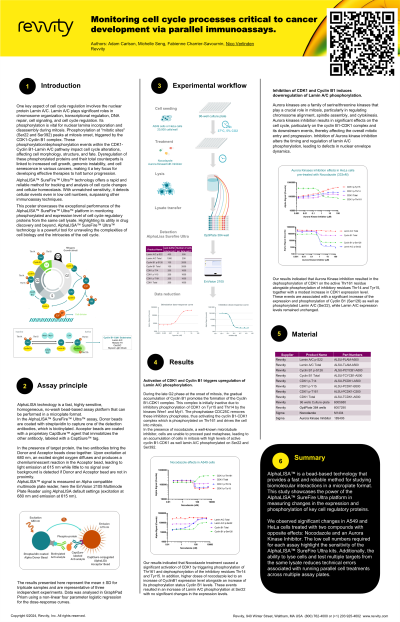Shaping the Future of Therapeutics
Poster Session A
(1100-A) Monitoring cell cycle processes critical to cancer development via parallel immunoassays
Tuesday, May 28, 2024
16:30 - 17:15 CEST
Location: Exhibit Hall


Nico Verlinden
Portfolio Leader Immunoassay Reagents
Revvity
Lier, Antwerpen, Belgium
Poster Presenter(s)
Abstract: Uncontrolled cell proliferation in many solid tumor types is caused by dysregulation of the cell cycle or genetic alterations in cell cycle regulatory proteins. The aim of this study was to demonstrate the utility of homogeneous no-wash immunoassays to monitor cell cycle changes induced by two drugs with distinct mechanisms of action, the topoisomerase II inhibitor etoposide, and a CDK4/6 inhibitor palbociclib. Thus, Jurkat cells were plated at 10,000 cells/well in a 96-well assay plate, serum starved, and allowed to settle overnight. Etoposide was added at increasing doses for 1, 2, or 4 hours after which cells were lysed. Next, 10 µL of lysate was transferred to separate plates and used in AlphaLISA SureFire Ultra assays (Revvity Inc, Waltham MA) to detect either total H2AX or phosphorylated H2AX (Ser139). Estrogen receptor-positive (ER+) MCF-7 breast cancer cells and receptor-negative (ER-) HCC1187 breast cancer cells were plated at 25,000 cells/well in a 96-well assay plate and allowed to adhere overnight. Cells were treated with a palbociclib dose-response for 20 hours to examine effects on phosphorylated Rb protein levels, or for 96 hours to determine prolonged exposure effects on Cyclin D1 (total and phosphorylated levels). Cells were lysed in HTRF lysis buffer and 16 µL of lysate was transferred to separate plates for use in HTRF assays (Revvity Inc, Waltham MA). Results from the AlphaLISA SureFire Ultra assay in etoposide treated Jurkat cells showed a time and dose-dependent increase in phosphorylated H2AX (Ser139), with a maximal effect seen at 4 hours with 100 µM drug. There was no measurable effect on total H2AX in Jurkat cells. This suggests DNA damage occurred, resulting in activation of a variety of DNA repair mechanisms including the phosphorylation of H2AX, which is followed by a sequential recruitment of MDC1 (mediator of DNA damage checkpoint 1) and MRN (NBS1/hMRE11/hRAD50) repair complexes. Results from the HTRF assays in a set of ER+ and ER- cell lines showed that palbociclib preferentially inhibited Rb phosphorylation in the ER+ luminal breast cancer cells while having no effect on the ER- cell line. Palbociclib is used in breast cancer therapy and leads to a decrease in cell proliferation, however this was not detected in an overnight treatment. Prolonged exposure to palbociclib resulted in an increase in total Cyclin D1 as well as phosphorylated Cyclin D1 (Thr286). This may be evidence of a cellular response indicating activation of evasion mechanisms used to bypass the inhibition of CDK4/6 to resume cell proliferation. In both sets of experiments, two separate homogeneous no-wash immunoassay technologies were used to rapidly and reliably detect the effects of drug treatments on critical components of the cell cycle. These results suggest the use of parallel assays to monitor both total and phosphorylated protein levels from the same cell lysates can be an important inclusion to drug discovery research.
